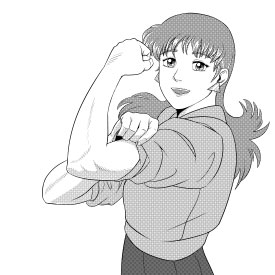
|
|
Ronin Warriors
|
|
Hello Ronin Warriors/Yoroiden Samurai Trooper fans! This is the last newsletter for the month of January, which means we're now down to the single digits of weeks left before submission deadline! How's everyone doing at this 9-week mark? Here we go with this week's updates:
|
|
1. The Fanzine Cover Voting ReminderHonestly, I can't believe we're at the end of January--where'd the month go? In just a few days our survey for what we should do for the cover will be closing. Ensure your opinion is counted by taking the survey before it's too late. Choices range from a public contest to an artless, generalized design. Don't wait; every vote counts (seriously)! And please be sure to include your name or alias, otherwise your vote will be removed from the results. Voting Closes:Results will appear in next week's newsletter. Get ready for some pie(charts)! |
|
2. Storytelling StylesHave you ever noticed the difference in storytelling between the East and West? Ever wonder what, how, and why they're so different? Aside from cultural differences, there are two unique schools of thought when it comes to developing a story. Generally, Western stories have a lot of planning done ahead of time, with creators mapping the beginning, middle, and end, then filling in the gaps with a similar thought process. How the story reaches its end is the focus. But not all Western storytellers follow this process; it's just much more prevalent in Western entertainment. The book, Invisible Ink is a great reference for anyone wanting to develop a story using this kind of method. The major con of using it is that stories can easily become predictable and formulaic (I'm looking at you, Marvel Cinematic Universe!). Generally, for Eastern storytellers, the focus is more on the journey and audience engagement. Many mangaka will write their stories as they go along, with a vague idea of how it could end. Manga series can be cancelled at almost any time, so the creators have to be flexible with how quickly they can resolve a plot line. Alternatively, a series can become wildly popular, and the creator has to add in more content to extend the series beyond what was originally planned (Dragon Ball Z, anyone?). In the book, Manga in Theory and Practice: The Craft of Creating Manga, master mangaka Hirohiko Araki of the Jojo’s Bizarre Adventure series, discusses his process for developing successful stories. He wrote that he doesn't always know how his protagonist will fair at the start of an ordeal, so the suspense the readers feel exists because it was felt by the author. This loose kind of planning has the danger of "writing oneself into a corner", where there's no way for the protagonist to succeed/win/learn/gain anything from the situation. There are pros and cons to both ways of developing stories, and there's no right or wrong way. It's great to find which one suits you the best, but it's also very helpful to explore the opposite style and stretch into other creative paths. Disclaimer: I'm not being paid nor receiving any payment for the promotion or link-referral purchase of the mentioned books. I personally loved them both and highly recommend them. |
|
3. A Bit of NostalgiaThe first time I saw Ronin Warriors on TV must've been during its original US run in 1995. It was episode 21, "Ryo's Mega Armor". I remember coming upon it while surfing through the channels on my grandma's "black box" (stolen cable, I later learned!). She saw that it was a cartoon, decided it must be for kids, and set me down in front of the 13" tube tv. I had no idea what the show was called, but I was instantly mesmerized by the boy in red with his white tiger companion struggling against an armored demon. I had landed square in the duel between Ryo and Saranbou, and I was hooked. And then, I never saw another episode... Until Toonami came to the rescue in 1999! The moment the commercial aired promoting the show, I nearly screamed with excitement. OMG! I recognize that character, and OMG I finally know the name of the show, and OMG I WILL FINALLY LEARN WHAT HAPPENED TO THE RED WARRIOR! Seriously, for the entire 4 year gap I was pretty sure he'd drowned and died, and the internet was too infantile at the time to let me find out otherwise when I didn't know its name. Good times. So, I'm curious, what was your first exposure to YST/RW, and were you hooked right away or did it grow on you? |
|
In summary:
Feel free to reply to this email if you have any questions. Countdown 9 weeks! Submission Deadline: |
|

|
|
|
Your privacy is important to us. Please send a message to this email with the subject, "unsubscribe me" if you no longer wish to receive emails from us. Disclaimer: By submitting art or writing to the fanzine project, submitter is stating they have created said works of art or writing themselves and have not stolen or plagiarized another's fan works. If a submission is found to have been submitted by a party other than the original creator, the submission will no longer be eligible to be included in the project. Submitter also understands that submitting their work automatically gives permission to the ronin warriors fanzine project to publish said work. The submitter still holds all rights and ownership of said work and may publish the work themselves in print or online as they see fit. It is not the intention of the project to receive any monetary compensation by the staff or submitters. All involvement in the project is voluntary and the final product is meant to be sold at cost to fans, staff members, and those who have submitted works. ©2018 Emily Wing |





